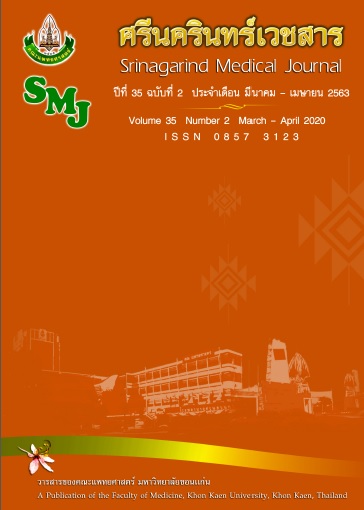Clinical Presentation and Outcome of Acute Pulmonary Embolism in Emergency Department, University Hospital, Northeast, Thailand
Keywords:
โรคลิ่มเลือดอุดกั้นในหลอดเลือดปอดเฉียบพลัน, ลักษณะทางคลินิก, แผนกอุบัติเหตุฉุกเฉิน, acute pulmonary embolism, clinical presentation, emergency departmentAbstract
อาการทางคลินิกและผลการรักษาของผู้ป่วยที่ได้รับการวินิจฉัยว่าเป็นโรคลิ่มเลือดอุดกั้นในหลอดเลือดปอดเฉียบพลันที่ห้องฉุกเฉิน โรงพยาบาลระดับมหาวิทยาลัย ภาคตะวันออกเฉียงเหนือ ประเทศไทย
กมลวรรณ เอี้ยงฮง, ชิดชนก เปลี่ยนศรี, กรกฏ อภิรัตน์วรากุล, แพรว โคตรรุฉิน,วัชระ รัตนสีหา, ปริวัฒน์ ภู่เงิน*
โครงการจัดตั้งภาควิชาเวชศาสตร์ฉุกเฉิน คณะแพทยศาสตร์ มหาวิทยาลัยขอนแก่น
หลักการและวัตถุประสงค์: อุบัติการณ์ของโรคลิ่มเลือดอุดกั้นในหลอดเลือดปอดเฉียบพลันในประเทศไทยยังไม่ชัดเจน ด้วยเครื่องมือในการวินิจฉัยและความรู้ในปัจจุบัน ทำให้การวินิจฉัยโรคหลอดเลือดอุดกั้นในหลอดเลือดปอดเฉียบพลันในประเทศไทยพบบ่อยมากขึ้นเมื่อเทียบกับสมัยอดีต ผลการรักษาโรคลิ่มเลือดอุดกั้นในหลอดเลือดปอดเฉียบพลันยังไม่มีการศึกษาชัดเจน การศึกษานี้จึงต้องการศึกษาอาการ อาการแสดง ข้อมูลทางห้องปฏิบัติการ วิธีการรักษา และผลลัพธ์การรักษาของผู้ป่วยที่ได้รับการวินิจฉัยว่าเป็นโรคลิ่มเลือดอุดกั้นในหลอดเลือดปอดเฉียบพลันที่ห้องฉุกเฉิน
วิธีการศึกษา: เป็นการศึกษาเชิงพรรณนาโดยเก็บข้อมูลแบบย้อนหลัง ในผู้ป่วยที่สงสัยภาวะลิ่มเลือดอุดกั้นในหลอดเลือดปอดเฉียบพลันที่ห้องฉุกเฉิน และได้รับการยืนยันการวินิจฉัยด้วยเอกซเรย์คอมพิวเตอร์ ที่โรงพยาบาลศรีนครินทร์ ในช่วงตั้งแต่วันที่ 1 มกราคม พ.ศ. 2551 ถึง 30 พฤศจิกายน พ.ศ. 2561
ผลการศึกษา: จากข้อมูลผู้ป่วยจำนวน 110 ราย เป็นเพศหญิง 67 ราย (ร้อยละ 60.91) อายุระหว่าง 22 ถึง 91 ปี อายุเฉลี่ย 62.4 ปี โรคมะเร็งเป็นโรคที่พบร่วมมากที่สุด (ร้อยละ 48.18) อาการและอาการแสดงที่พบมากที่สุดคือ อาการหายใจไม่อิ่ม (ร้อยละ 86.36) รองมาคือหายใจเร็ว (ร้อยละ 66.36) และชีพจรเต้นเร็ว (ร้อยละ 50.91) ภาพเอกซเรย์ปอดผิดปกติที่พบมากที่สุดคือ มีรอยโรคในเนื้อเยื่อปอด (ร้อยละ 40.91) ลักษณะคลื่นไฟฟ้าหัวใจที่พบมากที่สุด คือ sinus tachycardia (ร้อยละ 50) ผลอัลตราซาวด์หัวใจที่พบมากที่สุดคือ หัวใจห้องล่างขวาโต (ร้อยละ 48.44) ผลตรวจทางห้องปฏิบัติการได้แก่ D-dimer Troponin-T และ NT pro-BNP มีแนวโน้มเพิ่มสูงขึ้นในผู้ป่วยโรคลิ่มเลือดอุดกั้นในหลอดเลือดปอดเฉียบพลัน และมีผู้ป่วยเสียชีวิตในโรงพยาบาลจำนวน 5 ราย (อัตราตายร้อยละ 4.55)
สรุป: อาการทางคลินิกที่พบบ่อยที่สุดในผู้ป่วยโรคลิ่มเลือดอุดกั้นในหลอดเลือดปอดเฉียบพลันที่ห้องฉุกเฉินคือหายใจไม่อิ่ม ซึ่งไม่แตกต่างจากการศึกษาก่อนหน้าในต่างประเทศ ผลการรักษาพบอัตราตายมีความใกล้เคียงกับการศึกษาที่ผ่านมา
Background and objective: The incidence of acute pulmonary embdism (APE) in Thailand are unknown. With new diagnostic tools and current advanced knowledge, APE was discovered to be much more frequent in Thailand than earlier believed. Clinical outcome of APE had not been previously firmly identified. The aim of this study was to evaluation signs, symptoms, laboratory data, treatments and outcomes of patients diagnosed with APE in emergency department (ED).
Methods: The study design was retrospective descriptive study. We searched electronic databases (Jan. 2008 – Nov. 2018) for patients with suspected APE and diagnosed by computed tomographic pulmonary angiography (CTPA) in Srinagarind hospital.
Results: A total of 110 patients with confirmed APE was enrolled from ED. 67 patients were female (60.91%). The age of patients varied from 22 to 91 years old. The mean age was 62.4 years old. Malignancy was the most frequent co-morbidity (48.18%). The most common presenting symptoms and signs were dyspnea (86.36%), followed by tachypnea (66.36%) and tachycardia (50.91%). The most frequent radiographic abnormalities were pulmonary parenchymal lesions (40.91%). Most electrocardiograms were sinus tachycardia (50%). Echocardiography findings were RV dilatation in most cases (48.44%). D-dimer, Troponin-T and NT pro-BNP were increased in patients with APE. The mortality rate at the hospital admission was 5 in 110 patients (4.55%).
Conclusion: The most common clinical characteristics of APE patients in ED were dyspnea similar to previous reports in other countries. The mortality rate showed no difference when compared to previous studies.
References
Heit JA. The epidemiology of venous thromboembolism in the community. Arterioscler Thromb Vasc Biol 2008; 28: 370–2.
Horlander KT, Mannino DM, Leeper KV. Pulmonary embolism mortality in the United States, 1979-1998: an analysis using multiple-cause mortality data. Arch Intern Med 2003; 163: 1711–7.
Aniwan S, Rojnuckarin P. High incidence of symptomatic venous thromboembolism in Thai hospitalized medical patients without thromboprophylaxis: Blood Coagul Fibrinolysis 2010; 21: 334–8.
Konstantinides SV, Torbicki A, Agnelli G, Danchin N, Fitzmaurice D, Galiè N, et al. 2014 ESC Guidelines on the diagnosis and management of acute pulmonary embolismThe Task Force for the Diagnosis and Management of Acute Pulmonary Embolism of the European Society of Cardiology (ESC)Endorsed by the European Respiratory Society (ERS). Eur Heart J 2014; 35: 3033-69.
Kline JA. Diagnosis and Exclusion of Pulmonary Embolism. Thromb Res 2018; 163: 207–20.
Konstantinides SV, Barco S, Lankeit M, Meyer G. Management of Pulmonary Embolism: An Update. J Am Coll Cardiol 2016; 67: 976–90.
Stein PD, Beemath A, Matta F, Weg JG, Yusen RD, Hales CA, et al. Clinical characteristics of patients with acute pulmonary embolism: data from PIOPED II. Am J Med 2007; 120: 871–9.
Kline JA, Kabrhel C. Emergency Evaluation for Pulmonary Embolism, Part 1: Clinical Factors that Increase Risk. J Emerg Med 2015; 48: 771–80.
Sompradeekul S, Ittimakin S. Clinical characteristics and outcome of thai patients with acute pulmonary embolism. J Med Assoc Thail Chotmaihet Thangphaet 2007; 90: 59–67.
Jaff Michael R., McMurtry M. Sean, Archer Stephen L., Cushman Mary, Goldenberg Neil, Goldhaber Samuel Z, et al. Management of Massive and Submassive Pulmonary Embolism, Iliofemoral Deep Vein Thrombosis, and Chronic Thromboembolic Pulmonary Hypertension. Circulation 2011; 123: 1788–830.
Sekhri V, Mehta N, Rawat N, Lehrman SG, Aronow WS. Management of massive and nonmassive pulmonary embolism. Arch Med Sci AMS 2012; 8: 957–69.
Lemeshow S, Hosmer DW, Klar J, Lwanga SK, Organization WH. Adequacy of sample size in health studies [Internet]. Chichester: Wiley; 1990 [cited Dec 27, 2018]. Available from: http://apps.who.int/iris/handle/10665/41607
Roy P-M, Moumneh T, Penaloza A, Sanchez O. Outpatient management of pulmonary embolism. Thromb Res 2017; 155: 92–100.
Liu MY, Ballard DW, Huang J, Rauchwerger AS, Reed ME, Bouvet SC, et al. Acute Pulmonary Embolism in Emergency Department Patients Despite Therapeutic Anticoagulation. West J Emerg Med 2018; 19: 510–6.
Pollack CV, Schreiber D, Goldhaber SZ, Slattery D, Fanikos J, O’Neil BJ, et al. Clinical Characteristics, Management, and Outcomes of Patients Diagnosed With Acute Pulmonary Embolism in the Emergency Department: Initial Report of EMPEROR (Multicenter Emergency Medicine Pulmonary Embolism in the Real World Registry). J Am Coll Cardiol 2011; 57: 700–6.
Bajaj N, Bozarth AL, Guillot J, KojoKittah J, Appalaneni SR, Cestero C, et al. Clinical features in patients with pulmonary embolism at a community hospital: analysis of 4 years of data. J Thromb Thrombolysis 2014; 37: 287–92.
Laher AE, Richards G. Cardiac arrest due to pulmonary embolism. Indian Heart J 2018; 70: 731–5.
Corrigan D, Prucnal C, Kabrhel C. Pulmonary embolism: the diagnosis, risk-stratification, treatment and disposition of emergency department patients. Clin Exp Emerg Med 2016; 3: 117–25.
Clinical Update. Clinical Presentations of Pulmonary Embolism in the Emergency Department : Journal of Cardiovascular Emergencies 2017; 3: 133-7
Crooks S, Lang E. Prevalence of pulmonary embolism in syncope patients. CJEM 2018; 20: 432–4.
Gruettner J, Walter T, Bolte M, Haghi D, Sudarski S, Henzler T. Incidence of Pulmonary Embolism in an Emergency Department Cohort Evaluated with a Simple Symptom-based Diagnostic Algorithm. In Vivo 2013; 27: 215–20.


